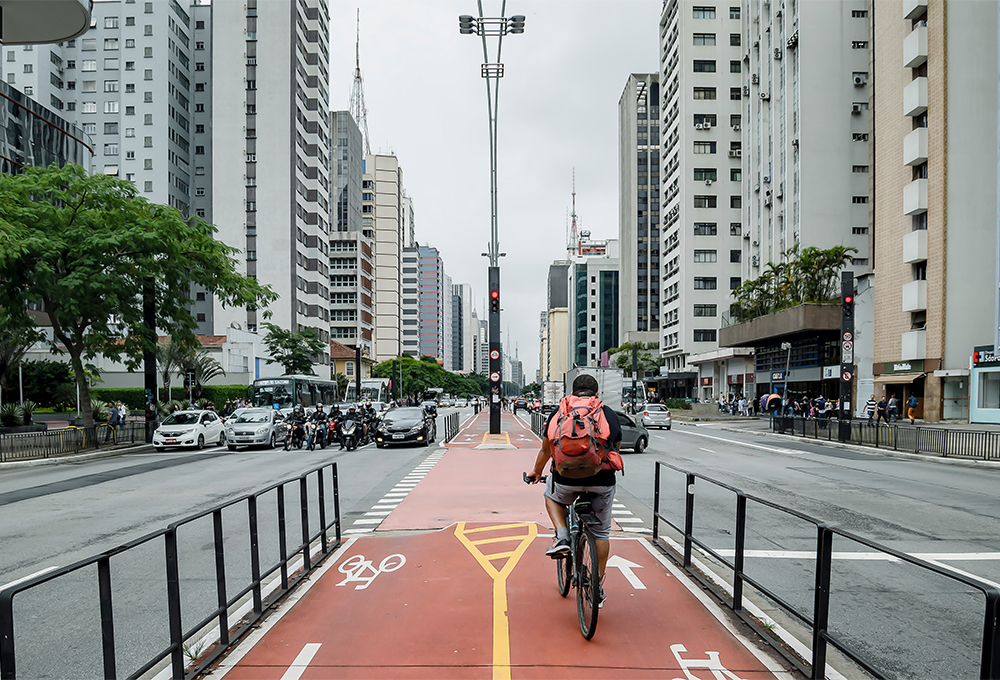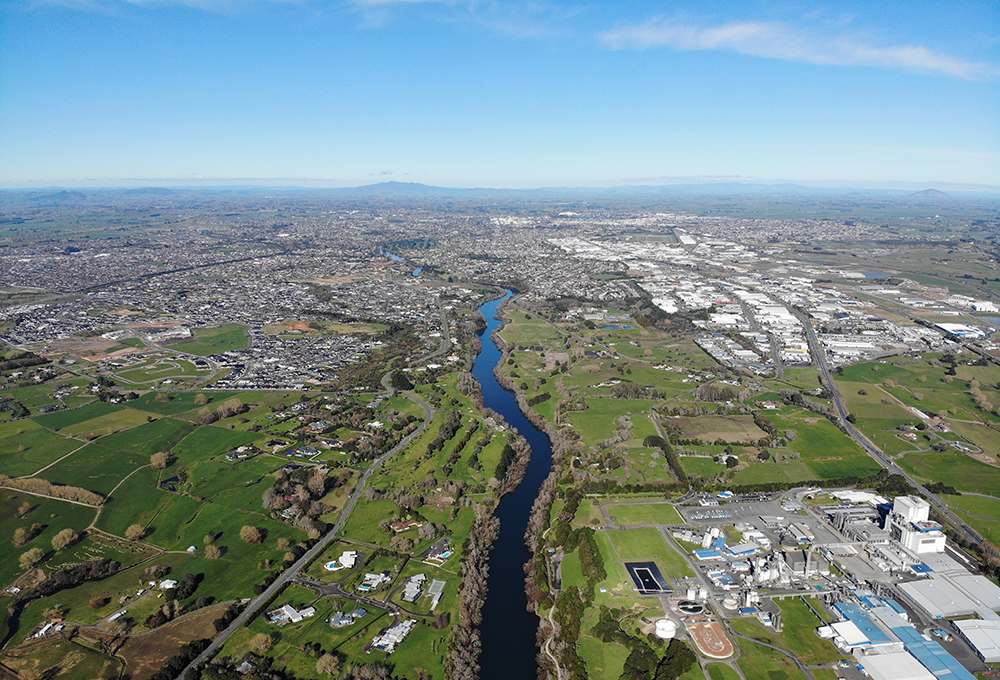Jump to section
Autonomous Vehicles
From self-driving cars to fully autonomous freight fleets, AVs could transform the transportation of people and goods.

Photo by chuttersnap on Unsplash
Autonomous vehicles (AVs) are vehicles that control their own operation and either require reduced input from a human driver, or do not need a human driver at all. AVs can be cars, shuttles and buses, freight trucks, or personal delivery devices that operate on the sidewalk. As long as most or all of the vehicle’s functions are automated, almost any type of vehicle can qualify. Many companies are currently working to develop AVs that require little to no human input to drive on highways and streets.
Variables to consider
Levels of Automation
For AVs, there are six levels of vehicle automation, according to the United States Department of Transportation and the Society of Automotive Engineers (SAE). Level 4 is the most advanced classification that is currently being produced and tested, while Levels 2 and 3 are the most advanced options available for purchase by consumers.


Types of Driverless Vehicles
There are two main types of vehicles that may complement and enhance driver input or replace it entirely: Connected Vehicles (CAVs) or Autonomous Vehicles (AVs). AVs and CVs primarily differ in how they operate. CVs rely on input from other vehicles, devices, or smart infrastructure to help operate the vehicle. AVs use their own technology to process and adapt to road conditions without communication from other vehicles or devices.
The Driving Environment
Driving conditions matter for AVs. The types and amounts of input that an AV needs to process and respond to vary depending on the weather, amount of light, the speed the vehicle is traveling, and the nature of the road and its users. For example, driving on a long stretch of straight highway with no traffic in broad daylight would be easier for an AV to process than driving in stop-and-go downtown traffic at dusk with lots of other vehicles, pedestrians, and cyclists. However, most initial deployments of AVs have been low-speed since lower speeds allow the vehicles more time to process information and react to the driving environment.
AV Ownership
While fully autonomous vehicles may be available for purchase by individuals in the future, it seems more likely that they will be owned and operated in fleets in the near-term. This is due to the expense of the technology and the need for frequent updates, as well as the emerging trend toward mobility as a service. Ridehailing models such as Uber and Lyft provide a glimpse of what transportation via AVs might look like if operated in fleets.
Innovation Drivers
- Safety is a critical concern in the current transportation landscape, and the hope is that AVs may be able to improve safety statistics. For example, in the United States, distracted driving is currently a major factor in car crashes. Replacing human drivers with precision-controlled computer systems to operate vehicles could effectively eliminate distracted driving. However, one study determined that AVs may only eliminate one-third of human-caused crashes.
- Technological advancements are making AVs increasingly feasible. Auto manufacturers are working hard to develop self-driving technology, and other technology companies are working to create technology-enabled infrastructure. On the user side, smartphone-based platforms that allow users to hail rides, purchase transit tickets, and unlock mobility devices like e-scooters have facilitated a shift towards viewing transportation as a service that can be accessed on demand.
- The increased convenience and comfort associated with eliminating the task of driving may appeal to drivers. The ability to recapture commuting time for more productive uses, like meetings or sending emails, or for leisure, such as watching a movie or even taking a nap, may be attractive alternatives for those who currently spend a lot of time behind the driver’s wheel. The “stickiness” of the notion of the private vehicle and its associated conveniences, either perceived or real, is already an important factor driving travel behavior.
- Congestion is also a factor driving the development of this technology. In 2018, a global study conducted by INRIX measured congestion in 38 countries around the world and found that traffic takes a serious economic toll on cities worldwide. Conceivably, AVs may be able to travel in closer proximity to one another and in narrower lanes, which could help ease congestion by increasing the efficiency of movement. However, such an improvement of free-flow capacity and flow stability will depend upon the penetration rates of connected and autonomous vehicles.
Barriers
- Pedestrian safety and the safety of cyclists and passengers is a critical issue in AV development. AVs have not yet mastered the ability to accurately identify and classify all objects, nor do they know how to respond in all scenarios because this requires a significant amount of testing. The technology will need to become advanced enough for AVs to be able to accurately identify all objects, process, and react appropriately without any latency before their wide deployment. The continued growth of this market hinges on these advances.
- Legal requirements vary across jurisdictions and may restrict or prohibit the use of AVs on public streets. This affects testing and operational abilities for AV manufacturers. AV manufacturers are increasingly interested in being able to test their vehicles on public roads in order to learn the critical information they will need for widespread deployment.
- AVs are expensive to develop and manufacture in their current state. This will influence who is eventually able to purchase, and even use, AVs in the future. It is currently expected that AV deployment will be stepped, and that AVs will operate under a fleet model, with a handful of larger companies owning, maintaining, and operating the vehicles. These fleet AVs would be available for hailing by users, similar to the way Uber and Lyft work today. However, there may still be some drivers who choose to own their own personal AVs, if and when they are available for purchase.
- Additional barriers include liability, licensing, security, and privacy concerns, as well as concerns about disruptions to the labor market. During negotiations between the Teamsters labor union and UPS in 2018, the Teamsters originally wanted to include a ban on the usage of driverless vehicles in their collective bargaining agreement. While there are concerns about the jobs that may be eliminated by AVs, there are also ways that AVs will not easily be able to replace human drivers, which may slow deployment. Bus drivers, for instance, also provide riders with boarding assistance as needed. In terms of AV goods delivery, autonomous delivery vehicles may be able to reach the curb, but the final leg of the delivery, from the curb to the door, will likely prove challenging until there are further technological advances.
Key players
- Automobile manufacturers including Tesla, BMW, Cadillac, Ford, GM, and others have all been working on developing vehicles with Level 3 automation or higher.
- Technology companies including Waymo, May Mobility, and TuSimple are working to achieve more advanced levels of automation that perform well in all driving conditions.
- Transportation network companies (TNCs) such as Lyft are working with automobile and technology companies to provide ride services to the public. The operation of current TNCs can also provide a model for how fleet AV services may function in the future.
Use case examples
AVs could provide expanded mobility options for people who cannot or choose not to drive for a variety of reasons. Having access to a self-driving car could expand transportation options for people with physical disabilities, older adults, and people who are not licensed to drive. Illness, fatigue, or intoxication are also cases where AVs could provide a safer transportation option.
AVs could be used to facilitate first- and last-mile connections to public transit. The first- and last-mile challenge is well-documented in transportation literature. AV shuttles could be used for on-demand rides to high-frequency transit stops and mobility hubs.
AVs could be used on long-haul trucking routes. Autonomous trucks could be used to transport goods on long-haul routes with human drivers taking over for the final leg of the journey into urbanized areas. There is also the opportunity for “platooning,” wherein multiple autonomous trucks travel together, which could increase efficiency and reduce the cost of freight movement.
AVs could be used for automated local delivery. Smaller autonomous vehicles and robots could be used on local streets to deliver packages, prepared meals, groceries, and other goods to consumers.
Pilots & developments
July 2002 – The Defense Advanced Research Projects Agency (DARPA), an agency under the United States Department of Defense, announces a series of competitions to motivate robotic and autonomous vehicle development. DARPA offers a prize of $1 million, approved by the United States Congress, to the winner of the first competition.
2009 – Waymo, a subsidiary of Google’s parent company Alphabet Inc., begins testing autonomous vehicles on their campus in Mountain View, California.
June 2011 – Nevada becomes the first state to legalize autonomous vehicles.
May 2013 – The National Highway Traffic Safety Administration (NHTSA) first defines “levels of automation” for autonomous vehicles. The initial levels defined by NHTSA have since been altered, most notably by SAE International in 2016. The automation levels initially defined by NHTSA and updated by SAE are ubiquitous across governments, academics, and industry today.
January 2014 – The Navia shuttle created by Induct Technology becomes the first commercially available self-driving shuttle in the United States.
October 2014 – Tesla’s “Autopilot” technology becomes available to consumers.
July 2015 – The University of Michigan opens Mcity, a test facility for autonomous vehicles. The Mcity test facility is the world’s first facility built for testing automated vehicles under many different conditions and environments.
August 2015 – The first autonomous bus trip is completed when the Yutong driverless bus successfully finishes a 20-mile trip in China’s Henan Province without any human intervention. The bus reached a high speed of 42 mph and encountered 26 traffic lights in total.
September 2016 – Uber launches their first self-driving pilot program in Pittsburgh, Pennsylvania. Instead of receiving rides from a regular Uber driver, trips could be completed in an autonomous vehicle with an on-board attendant.
October 2016 – Uber and Anheuser-Busch complete the world’s first commercial delivery using autonomous trucking with a delivery of roughly 45,000 cans of beer travelling from Fort Collins to Colorado Springs, Colorado
October 2017 – Waymo begins running Level 4 autonomous cars in Arizona.
November 2017 – The AAA shuttle becomes the first autonomous shuttle in the United States open to the public and operating on roads with live traffic. The shuttle is located in downtown Las Vegas, Nevada.
March 2018 – The first fatal crash involving an autonomous vehicle occurs in Tempe, Arizona when a pedestrian is struck and killed. After the incident, Uber, the owner of the vehicle, ceases its AV testing operations for the following nine months.
March & May 2018 – Waymo reserves orders for 20,000 Jaguar vehicles in March and 62,000 minivans from Fiat Chrysler Automobiles in May to upgrade with autonomous technology.
October 2018 – Waymo announces their autonomous vehicles have driven 10 million miles on public roads.
December 2018 – Waymo introduces the first autonomous ridehailing service, Waymo One, in Phoenix, Arizona.
April 2019 – Elon Musk, the CEO of Tesla, announces that the company will have “over a million robo-taxis on the road” in 2020.
September 2019 – Waymo opens a plant in Detroit, Michigan and earns the title of the world’s first dedicated autonomous plant. The factory equips existing vehicles with Waymo’s autonomous technology such as cameras, computers, and sensors.
December 2019 – Waymo One, Waymo’s autonomous ridehailing service, first completes a trip without a safety driver present in the vehicle.
January 2020 – Waymo CEO John Krafcik reports that Waymo’s vehicles have completed 20 million miles of on-road, fully-autonomous testing.
March 2020 – Many autonomous vehicle companies halt testing in the United States as the Covid-19 pandemic restrictions reduce travel and make it impossible to socially distance for safety drivers in vehicles.
December 2020 – Uber sells it's autonomous vehicle division to Aurora.
November 2022 - Argo AI folds
August 2023 - California Public Utilities Commission approves paid robotaxi service in the city 24/7.
August 2023 - California DMV restricts GM Cruise to half of its fleet after various safety and operations incidents.
October 2023 - California DMV halts GM Cruise AV operations after vehicle drags pedestrian. At issue was Cruise's lack of full disclosure about the incident.
Resources
Policies, Pilots, and approaches
Report – Academic
Using experience from working on the Knight AV Initiative, Urbanism Next created this white paper to provide a foundation for public sector agencies to approach autonomous vehicle deployment and policy with a focus on equity. This report outlines ways that public agencies can identify community needs and shape deployment to ensure that AVs will be accessible for all.
Communication tools
See something that should be here that isn't? Have a suggestion to make?






